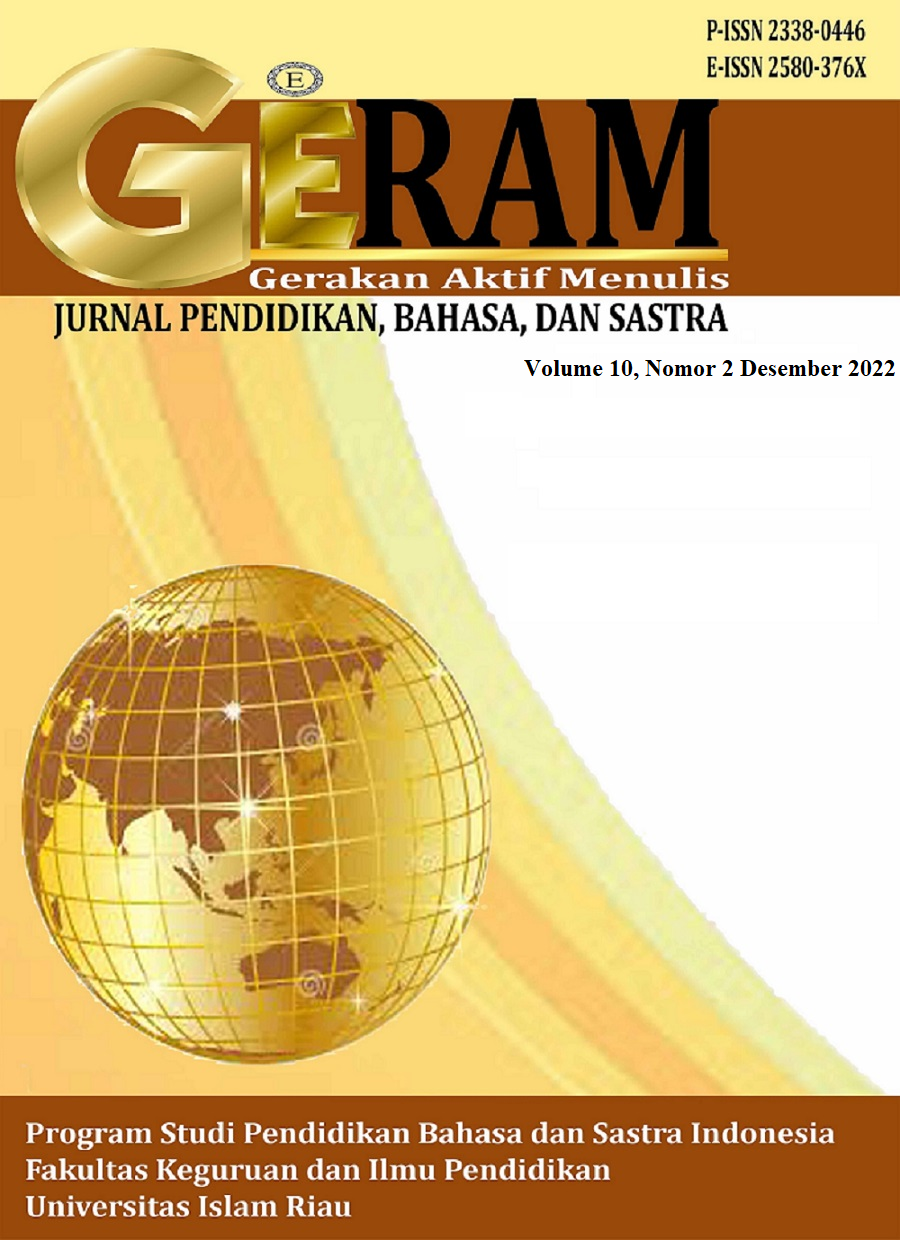Intervensi Superstisi terhadap Perspektif Adab bagi Masyarakat Minangkabau
Keywords:
superstition, adab, MinangkabauAbstract
Superstition and adab are among the many local pearls of wisdom in Minangkabau. Superstition is a statement that contains a supernatural meaning while adab is a condition that describes someone's unethical behavior. Contextually, there is a relationship between superstition and adab. The superstition that is formed in the life of the Minangkabau people is reconstructed from a civilization. The purpose of this paper is to describe and prove this relationship so that a common thread can be drawn regarding the relationship between superstition and Minangkabau people's manners. This research approach uses a qualitative approach. This study uses categorization techniques to reveal and interpret the data that has been collected. The data in question are the superstitions of the Minangkabau people which are reflected in adab, namely the manners of sitting, standing, walking, and behaving. Therefore, it is important to carry out an in-depth study to reveal the presence of superstitious interventions in Minangkabau society from the perspective of adab formation
Downloads
References
Adimiharja, Kusnaka. (1993). Kebudayaan dan Lingkungan: Studi Bibliografi. Bandung: Ilham Jaya.
Afnita, A., Saputra, D., Ulya, R. H., & Efrianto, E. (2021). Character Education as a Means of Second Language Development in Talented Children: A Study of Sociolinguistic. AL-ISHLAH: Jurnal Pendidikan, 13(3), 1696-1704.
Boeriswati, E., Lustyantie, N., & Ulya, R. H. (2021). Comparative Analysis Between Constructivism Methods and Modelling Methods on Skills Write Student Poetry. In Proceedings of the Tenth International Conference on Languages and Arts (ICLA 2021) (pp. 33-41). Atlantis Press.
Erni dan Herwandi. (2018). Pendidikan Nilai Karakter dalam Tradisi Lisan Nyanyi Panjang Bujang Si Undang pada Masyarakat Suku Petalangan Provinsi Riau. Jurnal GERAM, 6(1).
Erni, E., WS, H., Thahar, H.E., & Asri, Y. (2018). Nyanyian Panjang Bujang Si Undang as Oral Tradition in Melayu Ethnic; An Alternative Approach for Mental Revolution. Education, Social Sciences and Technology Application in Digital Era, pp. 430-436.
Erni, E., & Ulya, R. H. (2021). The Softskill and Hardskill forms of Tunjuk Ajar Melayu in Nyanyi Panjang Bujang Si Undang Palalawan Society of Riau Province. AL-ISHLAH: Jurnal Pendidikan, 13(3), 1688-1695.
Faizah, U. (2020). Etika Lingkungan dan Aplikasinya dalam Pendidikan Menurut Perspektif Aksiologi. Jurnal Filsafat Indonesia, 3(1), 14-22.
Hayati, Y., Ulya, R. H., Amazola, M., Hafrizal, H., Galuh, B. M., & El Husna, I. (2022). Optimization Reading to Learn Learning Model on Narrative Text Writing Skills for Junior High School Students. AL-ISHLAH: Jurnal Pendidikan, 14(4), 5099-5110.
Kartini Aboo Talib Khalid, ddk. (2012). Environmental Ethics in Governing Recycled Material Styrofoam for Building Human Habitat. American Journal of Environmental Science, 8(6), 591-596.
Katsui, Yoko dan Nader Ghotbi. (2012). Biophilia for Happiness and Environmental Ethics. Ritsumeikan Journal of Asia Pacific Studies, 31.
Kaur, Jasraj. (2015). Study of Environment Ethics Among Women. Issue Journal, 4, 194-195.
Keesing, F.M & R.M Keesing. (1971). New Perspectives in Cultural Anthropology. Chicago: Holt, Rinehart, and Winston.
Keraf, Sonny. (2002). Etika Lingkungan. Jakarta: Kompas.
Miles, Matthew dan Huberman, A. Michael. (1992). Analisis Data Kualitatif. Jakarta:UI Press.
Nahdhiyah, N. The Relation Between Human, Universe and God in Ahmad Fuadi’s Novel Anak Rantau. English and Literature Journal, 5(1), 46-54.
Pasya, Gumiwan Kamil. (2005). Strategi Hidup Komunitas Baduy di kabupaten Lebak Banten. Disertasi. Bandung: UNPAD.
Psarikidou, Katerina. (2008). Environmental Ethics and Biodiversity Policy in Tourism: the Caretta-caretta Case in Greece. Tourism Journal. 3, 153-168.
Rachmawati, Murni dan Andi Mappajaya. (2012). Local Wisdom in Java’s Architecture (Studied in Nature, Technology and Humanity). Academic Research Internasional Journal, 3.
Said, M.Y. & Nurhayati, Y. (2020). Paradigma Filsafat Etika Lingkungan dalam Menentukan Arah Politik Hukum Lingkungan. Al’Adl, Volume XII(1).
Samani, Muchlas dan Hariyanto. (2011). Konsep dan Model Pendidikan Karakter. Bandung Remaja Rosdakarya.
Schmieder, Allen A. (1977). “The Nature and Philosophy of Environmental Education: Goal and Objectives”, Trends in Environmental Education. (UNES-CO).
Suparlan, Parsudi. (1980). Manusia, Kebudayaan, dan Lingkungannya Perspektif Antropologi Budaya. Dalam: Yang Tersirat dan Tersurat. Fakultas Sastra: Universitas Indonesia.
Tyburski, W. (2008). Origin and Development of Ecological Philosophy and Environmental Ethics and Their Impact on the Idea of Sustainable Development. Sustainable Development 16, 100–108. DOI: 10.1002/sd.342.
Tilaar, HAR. (2000). Pendidikan, Kebudayaan, dan Masyarakat Madani Indonesia. Bandung: PT Remaja Rosdakarya.
Ulya, R. H., Thahar, H. E., Asri, Y., & Agustina, A. (2018, April). Cultural manifestation in superstition of Minangkabau society. In International Conferences on Educational, Social Sciences and Technology (pp. 422-429). Fakultas Ilmu Pendidikan UNP.
Ulya, R. H. (2019). Dimensi Keteraturan Sosial Wanita Hamil dalam Gamitan Superstisi Kubuang Tigo Baleh. Kafaah: Journal of Gender Studies, 8(2), 183-196.
Ulya, R. H. (2018). Reinterpretation of Ethic Value in Minangkabau’s Superstition. TELL-US Journal, 4(1), 47-57.
Ulya, R. H. (2022). Social Order Dimension in Superstition Pregnant Woman for Kubuang Tigo Baleh Society. TELL-US Journal, 8(1), 38-49.

















